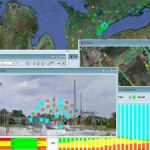Space-Time Insight uses Big Data to create a smarter grid …

If seeing is believing, then upstart Space-Time Insight could play a big role in the realization of a truly smart grid.
The company develops geospatial “situational intelligence” solutions that promise to help utilities dramatically improve the accuracy of generation demand forecasts, and in a much smaller window of time. That’s important for a number of reasons — including the quest to integrate more renewable energy generation sources into the global grid infrastructure.
Recently named to the 2013 Global Cleantech 100 list, the company already counts the Sacramento Utility District (SMUD), Canadian power producer Hydro One, the California Independent System Operator Corp. (ISO) and Czech Republic grid operator CEPS among its early, public customers. It also boasts some pretty serious partnerships with the likes of Accenture, EMC, Esri and IBM.
Solving the big data problem
“Utilities and every company out there have a big data problem that everyone is talking about: Now that you have all the data, what do you do with it?” said Steve Ehrlich, senior vice president of marketing for Space-Time Insight, which has its headquarters in San Mateo, Calif. “Our job is to pull it all together, and the way we do this is by visualizing the connections.”
The Space-Time software works by analyzing data from multiple sources, including sensors deployed across the transmission infrastructure that keep tabs on everything from meteorological factors (temperature, lighting, wind, etc.) to figures in the transmission system. It turns the information into visual dashboards that grid operators can use to get a better sense of what’s happening, in near real time. Aside from electricity, the platform could be applied to natural gas pipelines or water infrastructure, Ehrlich said.
“A customer will know they want to solve a specific business problem, but might not be able to see how to take action,” he said. “We can help with that.”
What problems can Space-Time Insight help address? The company’s customers are using the software to:
Predict failures and reduce maintenance costs: At CEPS, predictions are shown for a 48-hour period — covering systems that span the Czech Republic — in order to help the grid operator keep ahead of potential weather episodes that might have a negative impact on transmission reliability. All of the customers named above are also using the software for this purpose.
Balance generation sources: Aside from watching grid reliability, SMUD is using Space-Time to help integrate renewables more efficiently. The dashboards are helping teams develop switching plans and understand the impact of electric vehicle loads on single circuits. SMUD displays the visualizations on a 30 foot by 8 foot wall in its operations center, as well as on mobile devices.
Forecast demand: For ISO, one of the biggest challenges is to manage delivery of more than 50,000 megawatts across 25,000 miles of high-voltage transmission lines. Like SMUD, the organization is concerned with balancing alternative power sources as well as with managing bottlenecks and facilitating demand response strategies.
Ehrlich declined to be specific about the pricing for the software, saying only that is priced on a per-server basis. (It runs on either Windows or Linux systems.) However, he said Hydro One, which delivers electricity in Ontario, Canada, uses the software to closely manage reliability and maintenance concerns — was able to recoup its investment within one year.
Originally posted here:
Space-Time Insight uses Big Data to create a smarter grid …

